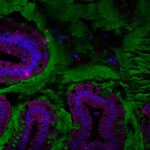Lien vers Pubmed [PMID] – 21339647
Lien DOI – 10.1172/JCI44632
J Clin Invest 2011 Mar; 121(3): 966-75
Crohn disease (CD) is a multifactorial disease in which an abnormal immune response in the gastrointestinal (GI) tract leads to chronic inflammation. The small intestine, particularly the ileum, of patients with CD is colonized by adherent-invasive E. coli (AIEC)–a pathogenic group of E. coli able to adhere to and invade intestinal epithelial cells. As the earliest inflammatory lesions are microscopic erosions of the epithelium lining the Peyer’s patches (PPs), we investigated the ability of AIEC bacteria to interact with PPs and the virulence factors involved. We found that AIEC bacteria could interact with mouse and human PPs via long polar fimbriae (LPF). An LPF-negative AIEC mutant was highly impaired in its ability to interact with mouse and human PPs and to translocate across monolayers of M cells, specialized epithelial cells at the surface of PPs. The prevalence of AIEC strains harboring the lpf operon was markedly higher in CD patients compared with controls. In addition, increased numbers of AIEC, but not LPF-deficient AIEC, bacteria were found interacting with PPs from Nod2(-/-) mice compared with WT mice. In conclusion, we have identified LPF as a key factor for AIEC to target PPs. This could be the missing link between AIEC colonization and the presence of early lesions in the PPs of CD patients.


